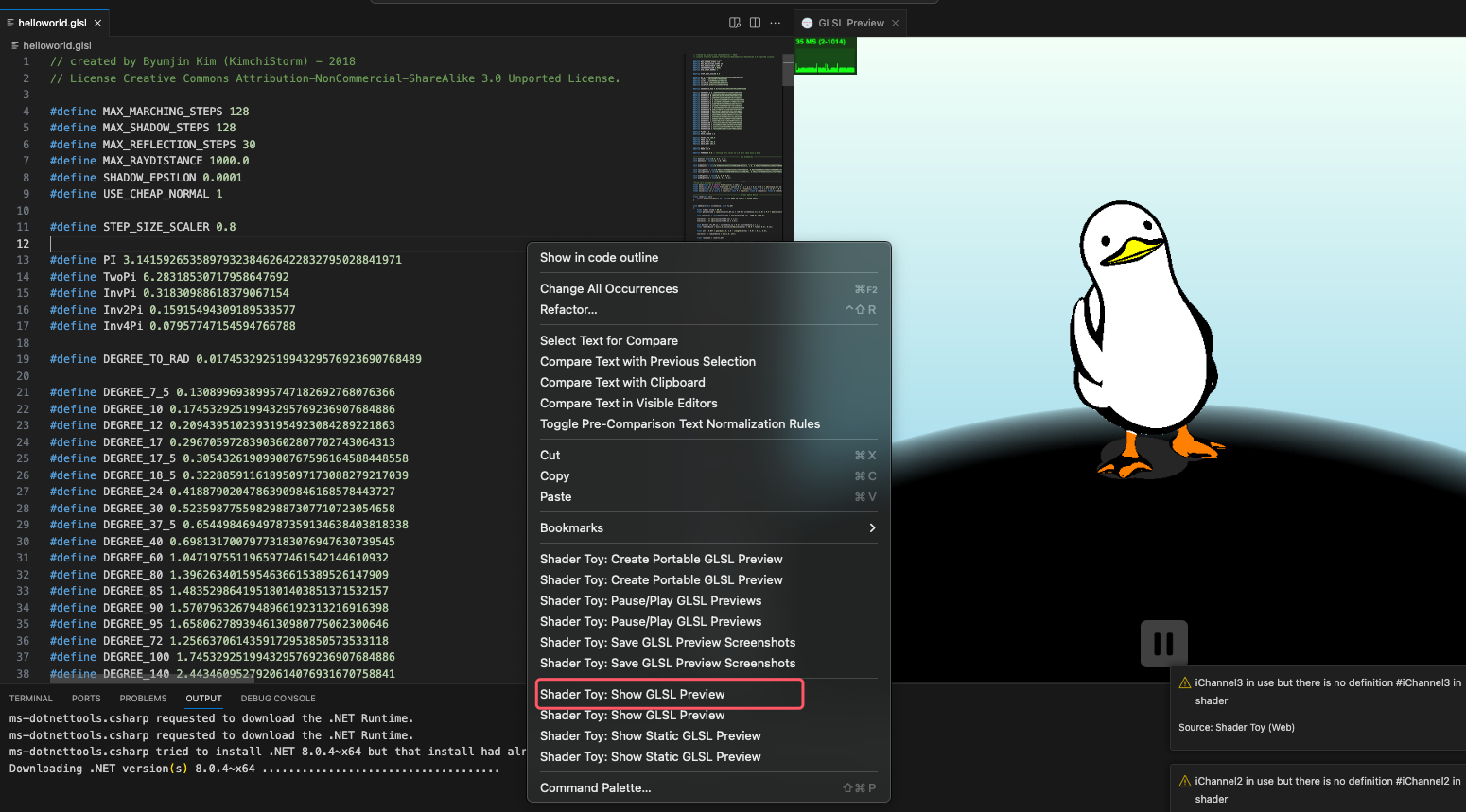1
2
3
4
5
6
7
8
9
10
11
12
13
14
15
16
17
18
19
20
21
22
23
24
25
26
27
28
29
30
31
32
33
34
35
36
37
38
39
40
41
42
43
44
45
46
47
48
49
50
51
52
53
54
55
56
57
58
59
60
61
62
63
64
65
66
67
68
69
70
71
72
73
74
75
76
77
78
79
80
81
82
83
84
85
86
87
88
89
90
91
92
93
94
95
96
97
98
99
100
101
102
103
104
105
106
107
108
109
110
111
112
113
114
115
116
117
118
119
120
121
122
123
124
125
126
127
128
129
130
131
132
133
134
135
136
137
138
139
140
141
142
143
144
145
146
147
148
149
150
151
152
153
154
155
156
157
158
159
160
161
162
163
164
165
166
167
168
169
170
171
172
173
174
175
176
177
178
179
180
181
182
183
184
185
186
187
188
189
190
191
192
193
194
195
196
197
198
199
200
201
202
203
204
205
206
207
208
209
210
211
212
213
214
215
216
217
218
219
220
221
222
223
224
225
|
const int MAX_MARCHING_STEPS = 255;
const float MIN_DIST = 0.0;
const float MAX_DIST = 100.0;
const float EPSILON = 0.0001;
float cubeSDF(vec3 p) {
vec3 d = abs(p) - vec3(1.0, 1.0, 1.0);
float insideDistance = min(max(d.x, max(d.y, d.z)), 0.0);
float outsideDistance = length(max(d, 0.0));
return insideDistance + outsideDistance;
}
float sphereSDF(vec3 p) {
return length(p) - 1.0;
}
float sceneSDF(vec3 samplePoint) {
return cubeSDF(samplePoint);
}
float shortestDistanceToSurface(vec3 eye, vec3 marchingDirection, float start, float end) {
float depth = start;
for (int i = 0; i < MAX_MARCHING_STEPS; i++) {
float dist = sceneSDF(eye + depth * marchingDirection);
if (dist < EPSILON) {
return depth;
}
depth += dist;
if (depth >= end) {
return end;
}
}
return end;
}
vec3 rayDirection(float fieldOfView, vec2 size, vec2 fragCoord) {
vec2 xy = fragCoord - size / 2.0;
float z = size.y / tan(radians(fieldOfView) / 2.0);
return normalize(vec3(xy, -z));
}
vec3 estimateNormal(vec3 p) {
return normalize(vec3(
sceneSDF(vec3(p.x + EPSILON, p.y, p.z)) - sceneSDF(vec3(p.x - EPSILON, p.y, p.z)),
sceneSDF(vec3(p.x, p.y + EPSILON, p.z)) - sceneSDF(vec3(p.x, p.y - EPSILON, p.z)),
sceneSDF(vec3(p.x, p.y, p.z + EPSILON)) - sceneSDF(vec3(p.x, p.y, p.z - EPSILON))
));
}
vec3 phongContribForLight(vec3 k_d, vec3 k_s, float alpha, vec3 p, vec3 eye,
vec3 lightPos, vec3 lightIntensity) {
vec3 N = estimateNormal(p);
vec3 L = normalize(lightPos - p);
vec3 V = normalize(eye - p);
vec3 R = normalize(reflect(-L, N));
float dotLN = dot(L, N);
float dotRV = dot(R, V);
if (dotLN < 0.0) {
return vec3(0.0, 0.0, 0.0);
}
if (dotRV < 0.0) {
return lightIntensity * (k_d * dotLN);
}
return lightIntensity * (k_d * dotLN + k_s * pow(dotRV, alpha));
}
vec3 phongIllumination(vec3 k_a, vec3 k_d, vec3 k_s, float alpha, vec3 p, vec3 eye) {
const vec3 ambientLight = 0.5 * vec3(1.0, 1.0, 1.0);
vec3 color = ambientLight * k_a;
vec3 light1Pos = vec3(4.0 * sin(iTime),
2.0,
4.0 * cos(iTime));
vec3 light1Intensity = vec3(0.4, 0.4, 0.4);
color += phongContribForLight(k_d, k_s, alpha, p, eye,
light1Pos,
light1Intensity);
vec3 light2Pos = vec3(2.0 * sin(0.37 * iTime),
2.0 * cos(0.37 * iTime),
2.0);
vec3 light2Intensity = vec3(0.4, 0.4, 0.4);
color += phongContribForLight(k_d, k_s, alpha, p, eye,
light2Pos,
light2Intensity);
return color;
}
mat4 viewMatrix(vec3 eye, vec3 center, vec3 up) {
vec3 f = normalize(center - eye);
vec3 s = normalize(cross(f, up));
vec3 u = cross(s, f);
return mat4(
vec4(s, 0.0),
vec4(u, 0.0),
vec4(-f, 0.0),
vec4(0.0, 0.0, 0.0, 1)
);
}
void mainImage( out vec4 fragColor, in vec2 fragCoord )
{
vec3 viewDir = rayDirection(45.0, iResolution.xy, fragCoord);
vec3 eye = vec3(8.0, 5.0, 7.0);
mat4 viewToWorld = viewMatrix(eye, vec3(0.0, 0.0, 0.0), vec3(0.0, 1.0, 0.0));
vec3 worldDir = (viewToWorld * vec4(viewDir, 0.0)).xyz;
float dist = shortestDistanceToSurface(eye, worldDir, MIN_DIST, MAX_DIST);
if (dist > MAX_DIST - EPSILON) {
fragColor = vec4(0.0, 0.0, 0.0, 0.0);
return;
}
vec3 p = eye + dist * worldDir;
vec3 K_a = vec3(0.2, 0.2, 0.2);
vec3 K_d = vec3(0.7, 0.2, 0.2);
vec3 K_s = vec3(1.0, 1.0, 1.0);
float shininess = 10.0;
vec3 color = phongIllumination(K_a, K_d, K_s, shininess, p, eye);
fragColor = vec4(color, 1.0);
}
|



